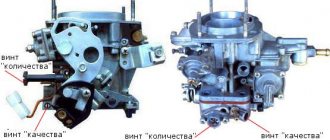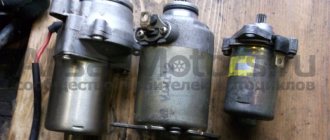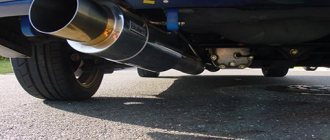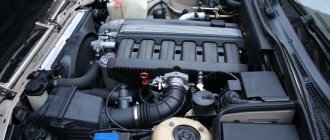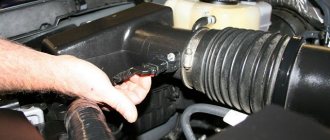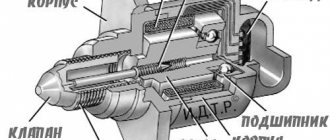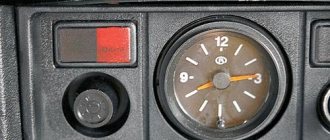There was something similar to 2112 25t.k. The engine stalls when starting, first the speed increases to normal, then smoothly to 0
When changing gears, when braking with the engine. It even happened when the clutch was disengaged. I measured the pressure in the ramp - it's normal, but when you're accelerating it increases (though only slightly). I changed the TPS (GM), spark plugs. I cleaned the RXX (pull the rod out completely) and lubricated it with lithium grease. I also cleaned the entire throttle body. The problem remained. The owner's patience ran out that day when the engine simply refused to work, stalling almost every time the clutch was pressed. It was decided to conduct a total diagnosis with compression measurements. Everything turned out to be too simple; the RTD vacuum hose at the very end was cut through with a clamp near which it was laid. The hose was cut. ALL ! dips, stalls, jerking disappeared.
For some reason, 16kl engines are more sensitive to air leaks than 8kl engines. On my 2111 engine, I disconnected the vacuum hose at idle for a test. There have been no changes, but 16kl is starting to work unstable. This is at idle, but under load it will naturally stall.
Conclusion: if replacing sensors in a circle does not help, look for air leaks bypassing the mass air flow sensor. There are many places where it can form. There is a good way to find leaks. When the engine is running at idle, spray the suspicious area with “Quick Start”. If there is a leak in this place, the engine will immediately respond with a short-term increase in speed.
The cause of a stalled engine is the spark plugs
In 50% of cases, the problem is due to the fact that the spark plugs simply do not produce a spark. This failure occurs as a result of 3 reasons:
- contacts become clogged;
- plaque forms along the entire contour of the candle;
- malfunction when supplying voltage to the spark plug.
However, the most popular is still black carbon deposits on the spark plugs, which prevents the spark from appearing or causes it to work periodically.
Tip: if the spark plug set malfunctions, you will hear a “triple” sound that is uncharacteristic of the engine. In this case, the car will jerk strongly while moving. As a result, the engine will either stall on its own, or you will need to turn it off and turn the ignition on again.
If you see dirt on the surface of the contacts, this indicates the need to replace a low-quality type of fuel or check the serviceability of the oil supply systems. It is the oil supply adjustment sensors that can splash the spark plugs with it if there is a problem. Also, oil that appears on a set of spark plugs may indicate serious damage to components in the engine cylinders. Be sure to check the engine at a car service center. Otherwise, further operation may lead to expensive replacement of jet rods and even the entire set of pistons.
If you systematically use low-quality gasoline samples, you may find a red-brown coating on the contour of the spark plug. In this case, cleaning will not help - it is better to immediately replace the entire set after a new refill. If you find that the car periodically turns off at full speed, but starts easily even with clean spark plugs, then the problem lies in the electrical wiring.
Functionality check
We have already talked about where the sensor is located. The first thing you need to do is find it and remove the block with wires. On a VAZ 2110, you must first unscrew the fastening elements of the throttle assembly, then move the entire assembly by about 10 mm.
Check with a voltmeter that the voltage is appropriate to the sensor. To do this, you must first connect the negative terminal of the battery to ground and connect a voltmeter to terminals A and D (they are usually marked), then:
- If the voltmeter shows less than 12V, this most likely indicates that the battery is not charged;
- If nothing is shown, faults should be looked for in the electronic control unit or in the circuit;
- If the reading is 12V or more, you need to check the regulator directly, or more precisely, its resistance;
- We connect a tester to the four terminals, which should give a total resistance reading of 50 or 55 Ohms.
Testing in pairs should give an infinitely large resistance. If the idle speed sensor on a VAZ 2110 (injector) gives different readings, it means it needs replacement.
You can also test the regulator in another way: remove the sensor and connect the block. Pressing the needle with your finger, watch its extension. When the ignition is turned off, there should be a push of the needle.
If everything is normal, then usually the speed does not fluctuate and the sensor itself is in working condition. If there is no shock, you can try cleaning the mechanism.
This is done using a special cleaner called WD-40. They very carefully, using a cotton swab, clean everything that is possible in the sensor.
Particularly carefully - the rod, as well as the needle. But if this does not help, a replacement is needed.
The cause of a stalled engine is a power supply failure
In this type of problem, 3 reasons may be involved:
- Poor contact with the terminals of the new battery;
- Detection of poor contact or breakdown along the entire length of high-voltage wires;
- The appearance of malfunctions in the generator or ignition coil system of the car.
If the problem lies in damp high-voltage wires, then it is best to replace them completely along with the battery contacts. If the terminals make poor contact, you need to carefully clean them with sandpaper and try to reconnect them. If the generator is found to be inoperable, the problem usually boils down to problems in the following parts:
- Broken timing belt;
- There is a malfunction inside the housing of the unit itself.
A problem with the generator is easily detected when the corresponding indicator on the dashboard turns on. In addition, if there is insufficient energy supply, the backlight of the on-board panel will gradually fade, and a set of other diagnostic sensors will show incorrect values.
Advice: if when you press the gas the car jerks, then stalls and cannot start, then the problem is related to the failure of the ignition coils. It is best to replace these parts in a car service using special equipment.
From the list of reasons that are directly related to the car engine, you need to move on to problems that arise in the fuel and air supply systems, as well as malfunctions of components responsible for exhaust gas removal.
Why can a VAZ 2110 stall on the road?
If a VAZ-2110 stalls on the road, many drivers are lost and do not know what action to take. It’s unlikely that your car will be repaired on the road, so the first thing to do is get to a service center or your garage.
This problem will occur quite often if you ignore it the first time. You will need to carry out a few fairly simple operations to identify the source of the problem. In extreme cases, you will have to go to a service center for professional help.
Fuel supply faults
It is quite easy to find out that the car stalls while driving due to the engine being “choked” with the fuel mixture - during a long drive you will find that the signal of the sensor responsible for this function is constantly on.
Here the problem lies in low-quality fuel, which does not quickly “ignite” from the spark of the candles. It can also be caused by gasoline not meeting the requirements for the octane number specified in the vehicle specifications. If there are problems with fuel, the gas pedal will be pressed all the way, and the car will not begin to gain speed. In addition, the car will periodically stall when the clutch is engaged.
Another symptom indicating problems with fuel is the appearance of problems with the car after refueling. The problem is characterized by a rapid drop in engine power at full speed, as well as when constantly changing gears. The way out of the situation is to completely drain the bad fuel mixture, wash the engine and all the fuel system pipes.
Also, the car will constantly stall if there is an interruption in the supply of the fuel mixture. This may be due to contamination in the following system components:
- Dirt in the fuel filter;
- Problems with injector nozzles;
- Dirty throttle valves;
- Fuel pump power failure.
The main symptom of a malfunction of these parts is that there will be a gradual drop in the power of the car’s engine, after which the car will stall even after sharply pressing the gas pedal. If you do not release the clutch carefully when changing gears, this will also cause the engine to stall.
The contamination of the fuel filter and fuel pump can be judged by the unstable operation of the machine even during idling and during rapid braking (when the supply of the fuel mixture decreases). And if the performance of fuel filters can be easily established during an external inspection and eliminated by replacing them, then to detect other causes, you need a full-fledged computer diagnostics, which can only be carried out in a car service center.
Another reason for a stalled car associated with the operation of the fuel pump is boiling gasoline in the fuel pump. This happens mainly in hot weather when the car is moving slowly or standing on the highway in traffic jams. The car will start to stall while driving, but when you turn on the idle speed and press the clutch, it will start again.
If boiling occurs, it is better to stand in a traffic jam with the engine turned off and gradually cool the car. After 5-10 minutes, the car's operation will be stable again.
Advice: if you recently did a wheel alignment with your own hands on a VAZ-2107, then to cool the car, proceed as follows - throw a piece of cloth made of dense material over the fuel pump body, which you first moisten with cold water.
Testing the mass air flow sensor (MAF)
Let us remind you what we are talking about - VAZ-2110 8-valve injector: the speed drops and stalls. A reasonable question arises: what to do? If the reason is not the IAC, then it is worth testing the mass air flow sensor. Here are some recommendations on how to do this:
- Disconnect the sensor connector from the on-board system. The controller that controls the engine will operate in emergency mode, but for short testing this is not fatal. If your car runs much faster, then the problem is most likely in the mass air flow sensor. It's time to clean it.
- Replace the sensor with a working one, and then see how the engine works. There are improvements, which means you need to either clean or replace your own mass air flow sensor.
- It also makes sense to inspect the air intake; to do this, you need to remove the mounting clamp and carefully inspect the inside of the air intake, there should be no condensation or oil there. If any are found, then it will have to be cleaned with special means.
- You can also test the mass air flow sensor using a multimeter. To do this, you need to switch the multimeter to voltmeter mode and set it to 2. The sensor has 2 wires - yellow and green. Yellow transmits a signal to the controller, and green transmits a signal to ground. When the ignition is turned on, we take measurements between these two wires. The engine should not be running. If the readings are in the range of 1.01-1.02, then the sensor is in perfect order. Readings in the range of 1.02-1.03 – it’s time to clean the sensor. And if the indicators go off scale to 1.04, then it’s time to get a new sensor.
Now we have figured out the main symptoms of a malfunction of the mass air flow sensor; neither testing nor troubleshooting is particularly difficult. It is quite possible to cope without after-sales service.
Malfunctions in the air mixture supply system
Here the problem lies either in a clogged air filter or in the failure of the regulator responsible for idling the car. In this case, your car will stall all the time when you gain speed or when you release the gas when you release the accelerator.
To solve the problem, remove and inspect the air filter. If there is serious contamination or chips, replace it. To diagnose and replace the idle speed regulator, you will need the help of qualified car service employees.
If the engine does not idle
Both experienced service station workers, professional drivers with many years of experience, and even amateurs identify a group of circumstances due to which the engine does not maintain idle speed. This includes:
- malfunction of the idle speed sensor;
- throttle valve clogged;
- malfunction of the throttle position sensor;
- contamination of the injector or carburetor
The reasons for the breakdown can be completely different, so when eliminating them you will have to use all sorts of actions and techniques. If you have considerable driving experience behind you, and you know the operating features of the car like the back of your hand, regardless of the model, then troubleshooting this kind of problem will not cause you any problems. And all because such breakdowns are not complex or serious. It follows that you can get your car working without outside help. Well, if your level of awareness or lack of free time does not give you the opportunity to eliminate all the defects yourself, it is better to seek help from knowledgeable people who can save you from unpleasant moments in the shortest possible time.
In the video, troubleshooting a problem on a car with a carburetor:
Car exhaust system problem
The engine may also stall if the tubes responsible for removing gases are malfunctioning. At full speed, the car will quickly begin to “choke”, and pressing the gas pedal completely stops the engine. Malfunctions in the operation of the exhaust pipe system in 90% of cases are caused by contamination and clogging of the muffler. However, the catalyst may also fail.
In the first case, carefully clean the muffler and remove foreign objects from there. If there are problems with the catalyst, conduct a complete diagnosis of the exhaust system and replace this element.
What to do if cars with automatic transmission stall?
If your vehicle has an automatic transmission, then the problem should be found in the electrical supply. If you abruptly switch from one gear to another, or while switching gears while braking, the settings may be distorted, and the on-board computer will receive a signal to turn off the engine.
Also, models with automatic transmission may stall due to malfunctions of the hydrodynamic transformers of the gearbox. This problem mainly manifests itself during acceleration and requires urgent intervention from car service specialists.
Fuel pump and grid
It is possible that a large amount of deposits has formed on the mesh, which is located directly in the gas tank, and while driving the required amount of fuel simply does not reach the engine, the gas pump does not pump with the required force, which causes the engine to stall. The fuel pump screen needs to be cleaned or replaced.
The difference between the new grid and the old one.
Idle speed sensor close up on an editorial VAZ-2112 Although a similar cause of malfunction is not inherent in this sensor, if it has not been checked for a long time, it is still not worth ignoring. If there are deposits on it, then it should be cleaned; if there is mechanical damage, then replace it. How to do this correctly is written in this article.
The problem is that the VAZ 2112 stalls while driving and won’t start (see description)?
In general, the story is this: I’m driving my two-wheeler on a flat road without puddles, and then bam, on a turn, it stalled, right on the move, the speed was decent 20-30 km per hour and I put it in 2nd gear, turned the key to the second position if I’m not mistaken the lights on the dashboard came on, the check engine light does not light up (well, when I turn it, it lights up), and when the car is started, it does not light up, I turn the key to phase 3, 0 reaction. By the way, the 16 valve engine is 1.5, which bends the valves, I tried this three times, it pumps to no avail, but the starter doesn’t turn, then two minutes later it started up with half a click, and drove home under its own power, the temperature was around 90 degrees, the fan was on, I checked the antifreeze in place, the oil in the engine was normal, I changed the idle speed control about a month ago so as not to lie, I also changed the ignition module, and immediately changed the ignition switch, then I drove for about 30 minutes, it behaves well, it doesn’t stall, I tried to start it with half a click when it’s hot, I didn’t try it when it was cold, I had this problem before, a very similar car stalled, but then the engine was damaged, the problem was in the ignition module, they replaced it, and by the way, which is quite important, it happened after about 5 minutes, literally after I refueled, I feed 92 gasoline
and yes, the injector really hopes for you
A fairly complete description of the possible reasons for the lack of starting of the engine of the “two-wheeler” was given by Olga Andreeva [225K]. But with all due respect, I must say that only two points (7 and 10) may be relevant to this case. In all other cases, the starter will operate. You write that the engine stalled and the starter did not work. This means that the problem must be looked for in the electrical circuits, starting from the battery terminals common to the starter and ECM. It should be noted that if there is poor contact of the “negative” wire with the car body, turning on the ignition is usually accompanied by a blown fuse in the controller’s power circuit, which cannot be eliminated in itself. This means that “positive” circuits remain. This could be bad contacts in the connectors, in the ignition switch, between the tips and wires, wear of the relay contact groups, as well as the destruction of solder joints on the printed circuit board of the relay unit. Moreover, it happens that upon external inspection the soldering looks normal, but inside it there is oxidation of the lamella. And the latter seems to me to be the most likely. There may also be several bad contacts simultaneously or alternately. So it is best to audit all wiring.
What hope do we have? There aren't many telepaths here. There are a couple, but they are not on the site now. But today my husband is at home, so I resort to his experience and knowledge. Let's take it in order. The fact that the engine bends the valves is not simply taken into account by a caring car owner. He is trying to get rid of it. Nowadays, just for one and a half cars, and for the Priora, a piston group is sold, which is deprived of this wonderful advantage, and has recesses for the valves on the bottom of the piston. You should replace the piston with a normal one, so that you no longer grab your heart as soon as the pepelats stalls. And if the belt breaks, it will stall. At the same time, the starter will turn vigorously. But the compression cycles will not be heard. That is, the engine will rotate without any noticeable effort and easily. This is the first sign of lack of compression, and as a result of bent valves. Any experienced auto mechanic can hear this by ear. He doesn’t even need a compression meter to understand that it’s tobacco. Such “corpses” are dragged to my husband every other day or two. Like, they started it, started it, but it won’t start. Therefore, as advice - change the piston . This is cheaper than repairing the engine every time after a belt breaks, which is not always of high quality and does not always last the 40,000 km it is supposed to. It's like once.
But this is clearly not your problem, because the car starts after a while. Now I will write the most typical reasons for this behavior of the car:
- Poor contact in the crankshaft sensor connector. In this case, after starting, the check light will light up, and an error for this sensor will be recorded in the ECU memory. “Open circuit.”
- The crankshaft sensor itself either has an interturn short circuit, or any dirt has stuck to its tip. Most often, metal shavings of various origins. Don't be surprised - it's all the time. Fine metal dust adheres to the magnetic core of the sensor and interferes with its operation.
- The reference disc may turn. Either due to poor tightening of the crankshaft pulley bolt, or if the damper has delaminated. It would be a good idea to replace the pulley with a cast iron pulley without a damper. It costs 2 times less, and eliminates all kinds of surprises associated with it.
- Perhaps there is an extraneous emmobilizer in the car. Check the interlock circuit of this device, if there is one at all.
- Exactly the same thing, but with a standard immobilizer. It happens that the key antenna malfunctions, or for some other reason the system loses contact with the chip. On more modern cars, such as Priora, in this case the “key” light on the panel lights up.
- The fuel pump relay has expired. It sometimes needs to be changed, because the contacts in it burn out from time to time. The fuel pump is a rather energy-intensive thing, and the relays in this circuit operate less than in others. Especially if the pump is worn out and its current consumption is higher.
- Exactly the same applies to the ignition relay. If there isn’t one (because there are cheaper cars that didn’t have them installed), then exactly the same applies to the contact group of the ignition switch.
- Fuel tank canister valve malfunction. Its task is to ventilate it. If the valve is faulty for some reason, or the line is faulty, then the pressure in the tank may be negative. It becomes difficult for the pump to lift fuel, and the pressure in the gas line drops. The car stalls. Treated by unscrewing the gas tank cap once. In this case, there will be a sharp “snort” of incoming air. Malfunction is rare.
- Fuel boiling in the ramp. In your case, this is unlikely, because most likely there is a return line. But on cars where the fuel pressure regulator is located in the tank, and not on the ramp, this is possible.
- Poor contact of the ground wire powering the car body. You should clean the place where it is attached, both to the body and to the terminal. It’s even better to solder the mounting terminals themselves. A characteristic sign is that the instruments (antifreeze temperature and gasoline) show nonsense.
Here's the main thing for you. It is not possible to answer in absentia what exactly caused this event for you.
VAZ 21124, 1.6, 16 cl. stalls immediately when cold. 2008
August 23, 2021, 11:13 pm #1
So, let's go. It started stalling two weeks ago in the morning after being left idle (when it was cold). I sat down, started to start it, it started up, it started to stall for about 5 seconds and stalled, I started it a second time, the revs were floating, it didn’t stall, the revs leveled off. The next morning, the second time it didn’t start, it also stalled. The third time it helped, only applying the gas for 10-15 seconds, the stalling stopped, but the revs fluctuated. When the revolutions drop to 1000 revolutions, it starts to triple (as if one cylinder stops working, vibration in the body), it drops lower, everything is fine (800-850), when hot it always starts perfectly, without glitches or shaking. At third speed you can feel the car jerking, but only at third. I went to the service center and measured the compression - normal. Fuel pump pressure is normal. I changed the spark plugs - it didn’t help, I began to blame the ignition coils, I checked with the engine running, cordoning off each one, there is a reaction, each cylinder starts firing - normal. I read the forums, watched the video, did the following: I cleaned the throttle valve with a carburetor can, also Pxx, and replaced the hose from the adsorber to the throttle, the next morning nothing had changed, I read about the mass air flow sensor, removed the plug, started it - the same problem, not the mass air flow sensor . I washed the injector with some liquid at the service center. On the trail. the day I changed the coolant sensor (at the service center they said that it was definitely him, yeah..). Today I changed the diaper and the fuel filter, I think the same effect will happen tomorrow morning, I don’t know where to dig anymore, there are few options left, brains, injectors (more precisely, seals, although I don’t know, everything works fine when hot), still change Mass air flow sensor, IAC, coils, battery, oil, firmware, injectors, but I think none of this will help me again. Help, anyone who has encountered this kind of crap, VAZ 21124, 1.6, 16th class, 2008. I’ve already broken my head, but in the service centers they don’t know anything, just guesses, the diagnostics also don’t show anything, they turn on the fools, they make a smart one view only. Let me know if this helped anyone, I’m just tired of throwing money down the drain.
VAZ 2109 Lada Granta Sedan
August 24, 2021, 07:14 #2
Most likely DMRV.
Get rid of the MAF. Set DBP. If the “brains” are ITELMA, everything is flashed, I have already redone a lot, well, not a lot, but a few cars, and people contact me.
August 24, 2021, 08:36 #3
I also think about the DMRV, at least you can check with a multimeter whether it is “live” or not without service, have the valves been adjusted long ago? maybe they are the problem
VAZ 2109 Lada Granta Sedan
August 24, 2021, 08:39 #4
16th grade, there are hydraulic pushers, they can fool, they are poorly diagnosed.
Lada Vesta MTZ-1221
August 24, 2021, 09:32 #5
does it give an error? if you add gas to 2000-3000rpm when it’s cold. how does the motor work?
24 August 2021, 19:19 #6
Slow, August 24, 2021, 07:14, #2
Most likely DMRV. Get rid of the MAF. Set DBP. If ITELMA's brains, everything is flashed, I've already redone a lot, well, not a lot, but a few cars, and people contact me.
rinat-q3, August 24, 2021, 08:36, #3
I also think about the DMRV, at least you can check with a multimeter whether it is alive or not without service, have the valves been adjusted long ago? maybe they are the problem
I measured the mass air flow sensor today, it shows that it is alive, and very much so.
Slow, August 24, 2021, 08:39, #4
16th grade, there are hydraulic pushers, they can fool, they are poorly diagnosed.
as an option, I agree, they knock while I fill up with Lukoil so that they don’t knock, now they ring when I’m driving under tension, I plan to follow. month to change along with the gasket.
Flying, August 24, 2021, 09:32, #5
Does it give an error? If you add gas to 2000-3000 rpm when it’s cold. how does the motor work?
works great, everything is good in this regard.
In general, I reviewed the videos on how to check the IAC, TPS sensors, started with the TPS, the multimeter showed nothing, “0.00”. I decided to pull out the connector and start it (on hot), as a result, the speed does not drop, I put it back, I press the pedal and release, it drops for half a second or a second to 700 and levels out to 800-850, I went to the store, I decided not to buy at first check, twisted it, started it, the same thing, they don’t sag, they fall evenly, not quickly, 250 rubles, it doesn’t look original, why am I writing this, I started driving, the engine works perfectly, but when the pedal reaches the middle, it disappears, then traction appears, I release the pedal, and I press it again - it goes, and so on until the middle, then it repeats, I read somewhere that you need to reset the negative temperature for 5 minutes after replacing, I hope this is the case, otherwise you will have to look for another sensor, if that's the case in him. This is all about the fact that the revs are dropping, tomorrow morning I’ll start it, I think it will start, that was the problem, I’ll write back when I get home.
26 August 2021, 13:14 #7
So. I changed the TPS in the store, installed it, the same damn thing. Press the pedal halfway and you are guaranteed to lose traction, but the car just starts perfectly when cold. Both sensors were not neat, crooked inscriptions with numbers, judging by this - Chinawanpun. I returned the money. I went to another store, bought a TPS, and installed it. It works exactly the same as the old one, I press the pedal, release it, the revolutions drop sharply below 1000 to about 700, and only after a couple of seconds they reach 800-850. And the Chinawanpun lowered the speed for me smoothly and without sagging, but the traction disappeared. Guys, bros, what’s more enjoyable than hammering on the hood?
Lada Vesta MTZ-1221
26 August 2021, 14:45 #8
depends on what gear? those. only in higher gears or in any, but at certain speeds?
26 August 2021, 15:13 #9
Flying, 26 August 2021, 14:45, #8
depends on what gear? those. only in higher gears or in any, but at certain speeds?
Yes, my friend, in any gear, at some speed. Unfortunately, I was not prepared for this issue and did not look at what speed this happens.
26 August 2021, 15:36 #10
Dean1823, 26 August 2021, 15:13, #9
Yes, my friend, in any gear, at some speed. Unfortunately, I was not prepared for this issue and did not look at what speed this happens.
then you write that it jerks only in third gear, now you write that in any
I had 21124, the motor is the most reliable and very simple, at the slightest malfunction the check light comes on for any diagnostics, everything is easily diagnosed and treated
26 August 2021, 15:45 #11
And it stalled for me only in two cases, the first was when the belt broke and the second was due to a faulty IAC; once it stalled due to a faulty coil but did not stall; there were never any problems with it again. Diagnostics always and accurately indicated a malfunction
26 August 2021, 16:10 #12
Russo, August 26, 2021, 15:36, #10
then you write that it jerks only in third gear, now you write that in any
I had 21124, the motor is the most reliable and very simple, at the slightest malfunction the check light comes on for any diagnostics, everything is easily diagnosed and treated
buddy, be more careful. on the third, it only happens with the old sensor, and it’s barely noticeable, let’s say I have a figure eight on the wheel, or the road is not smooth, well, I feel minor shocks, only on the third. And with the Chinese Vanpui sensor, my traction just breaks off, bro. Understand? It’s as if I pressed it halfway and suddenly released it, but I don’t let go of the pedal. I’m not saying anything about the engine, my engine works well. And no, you are not at all right, the check does not always light up. And again I was wrong, until I climbed in, three diagnosticians didn’t find anything, they only fought back by saying: “Let me get the coolant sensor. Jew. I’ll change it,” another also advised nonsense: “It’s clearly the fuel filter! And the diaper needs to be changed!”, in the end, for some reason, after sitting for 5-10 minutes, the car stinks of gasoline, so they fucking changed it.
Russo, August 26, 2021, 15:45, #11
And it stalled for me only in two cases, the first was when the belt broke and the second was due to a faulty IAC; once it stalled due to a faulty coil but did not stall; there were never any problems with it again. Diagnostics always and accurately indicated a malfunction
With one faulty coil, the 124 should not stall, at least not right away.





